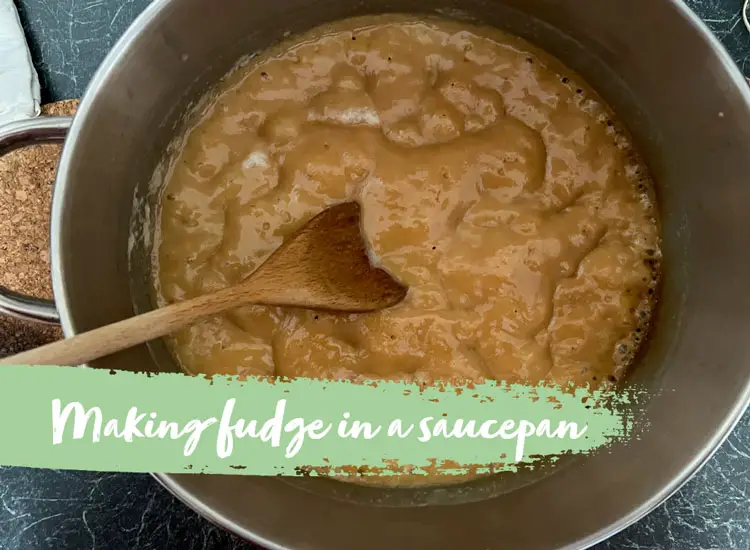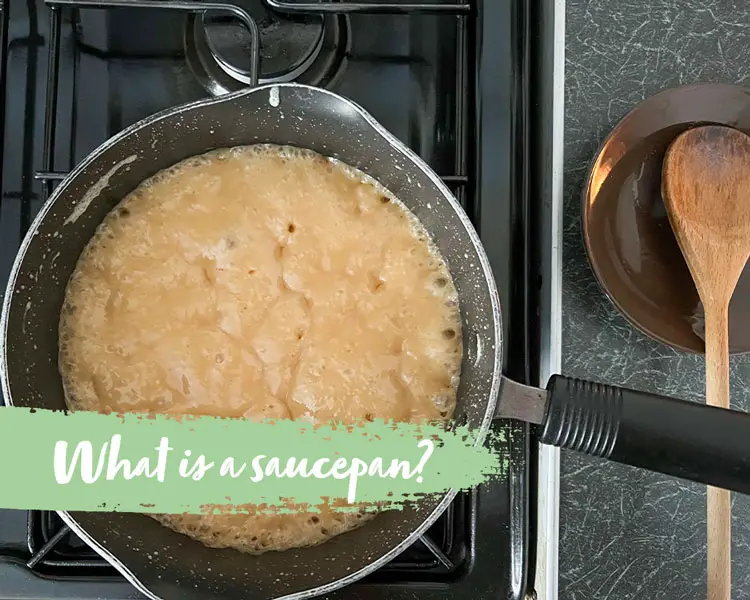When making desserts or any type of food, there is a wide variety of pans that come to mind. You could use a frying pan, sauté pan, cast iron, a dutch oven, a sauce pot, pots and pans with a glass lid, a stainless steel saucepan…the list goes on and on.
But if you are making fudge or need to melt wet ingredients, a saucepan works wonders. But you may be wondering what is a saucepan?
A saucepan is a small pot with a lid that works as an effective tool for cooking and reducing wet ingredients for a variety of different foods. Saucepans can withstand low and high heat and evenly cook ingredients whether you are boiling liquids or reducing a thick sauce.
When asking the question, what is a saucepan, there will likely be numerous answers since this cooking tool is not easily defined.
In this guide, we will tell you everything you need to know about saucepans and why a heavy based saucepan is a necessity for making the perfect batch of fudge.
We will also take a closer look at how to tell a saucepan apart from many other types of pots and pans. Read on to find out more.
Why is it called a saucepan?
In short, a sauce pan (saucepan) is named as such because it is primarily used to heat and cook liquids that most commonly take on the consistency of a sauce.
The sauce in question can be savory, such as pasta sauce, tomato sauce, or gravy, or sweet as in dessert sauces such as fudge.
Many people use a sauce pan to cook acidic foods or to cook pasta or mashed potatoes. The heat distribution for a large saucepan can be particularly useful for blanching vegetables in addition to making sauces.
The name means just that, and this should always let you know that heating liquids are the primary purpose for these pans.
Uses of a saucepan
Thanks to the large surface area, tall sides, long handle, and straight edges of a saucepan, the cooking methods for these pans are versatile.
The pan can function as a frying pan for deep frying thanks to these contours or for thickening sauces, simmering water, or reducing sauces.
For example, making fudge is best utilized in a single saucepan with non-stick coating for smaller quantities or large saucepans for larger quantities.
The high walls trap the heat inside the pan which allows for high temps needed to boil and potentially set fudge.
Saucepans can also be used for making soups, making stocks (small quantities, not large quantities), and handling liquids of all varieties.
How do you identify a saucepan?
To properly identify a saucepan, look for taller sides, deeper sides, and rounded corners. This will help to distinguish this pan from a regular pot.
But it is important to also look for a flat bottom as a key difference between a saucepan vs. practically any other pan. Saucepans are sometimes confused for stock pots or pots used to boil liquids.
A key indicator is that the saucepan will be much smaller as you only want to evenly cook a sauce and not cook it thoroughly to the point of the liquid changing its consistency.
Sauté pans can also be confused with saucepans. Sauté pans will typically have a much larger base for high-volume sauté consistency.
There needs to be room for whisking and combining multiple ingredients nearly to the point of frying. This is not what saucepans are used for.
Sauté pans are designed to hold more food than a few simple ingredients that are typically found in saucepans.
Although saucepans can be used for boiling water or other liquids, this is not what they are designed for exclusively. A stock pot or double boiler can be used for these purposes.
Saucepans can also be confused with frying pans, but the key difference will be that a saucepan has a lid and is a bit deeper than a pan used for frying.
Cast iron skillets and dutch ovens are a bit easier to tell a difference between when comparing these deeper pots to a saucepan.
Difference between saucepan and frying pan
Since pans used for frying bear the closest resemblance to saucepans, look for these key indicators to tell these kitchen tools apart:
- Width. Saucepans are a bit deep and commonly mistaken for small pots. A frying pan is longer, not very deep, and does not always have a long handle.
- Sides. Saucepans have straight sides by design. A frying pan is a bot more versatile to allow more air into the cooking process.
- Lid or no lid. Saucepans almost always have a lid. Some pans used for frying may come with lids, but will not be as deep as a saucepan.

Using a saucepan for making fudge
When you are making fudge, using a saucepan is ideal due to the high side walls to accommodate fudge volume. Also, a thick bottom saucepan is best to prevent burning.
At Call Me Fudge, we use saucepans often when making traditional fudge as we find that the consistency is almost always perfect when compared to using a pot or a dutch oven -even when using a double boiler.
Additionally, using a saucepan that is made of stainless steel adds more convenience to the cooking process.
You can assure just enough high heat to find the perfect temp, and you do not have to worry about the fudge sticking to the pan -which is truly a nightmare!
A stock pot is just far too big for making fudge, and not using stainless steel means you will constantly have to monitor the fudge and stir much more than you would need to do otherwise.
Cleanup is also a breeze too since most saucepans are dishwasher safe.
I have also found that using a saucepan makes it so much easier to set a candy thermometer into. Larger pots and pans would simply swallow the thermometer into the mixture.
In closing, using a saucepan for making fudge is a matter of high convenience. Both professional chefs and home cooks alike use saucepans for making fudge.
So make sure you acquire one if you haven’t got one already.
FAQs
Can you fry things in a saucepan?
Technically, you could very well fry some things in a saucepan, but it is not ideal.
The pan is too deep to allow even frying, not to mention the smaller length to work with inside the saucepan.
For best results, make sure you fry foods in a frying pan, and if a lid is needed, there are frying pans that come with a custom lid.
Can I bake in a saucepan?
For baking, it is best to acquire an oven-safe saucepan, but it can be quite difficult to find these.
As long as no part of the handle or pan is made of plastic or anything that could melt in oven temperatures, you could do this. But be extra cautious if you decide to.
It is best to use a cast-iron skillet or dutch oven if you need to have a deep baking dish for the oven.
These types of pots can withstand oven temperatures and are even designed to be used inside ovens. A saucepan is not typically designed for oven use.
Can I use a saucepan for slow cooking?
You can use a saucepan for slow cooking. The key would be to ensure that you watch your temperature fluctuations and adjust accordingly based on the consistency you are looking for with the sauce.
For fudge, the results would be better if you used a slow cooker as opposed to slow cooking the ingredients in a saucepan.
A slow cooker would allow you to control the temperature variations a bit more easily rather than trying to achieve this with a saucepan on low heat.
In Summary
In closing, a saucepan is a versatile and essential type of cookware to use for cooking a variety of liquids and wet ingredients for desserts. You can also use these pans for simmering or cooking a variety of savory liquids or types of gravy as well.
When you compare saucepans to other pots and pans, always ensure that the pan is a bit small with a lid and has deep (but not too deep) sides. A saucepan is perhaps the best pan of all for making fudge.
Want to know our top picks of saucepans for making fudge? Read this:


